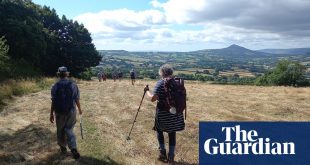A new study revealing Britain’s greenest cities could lead to a boost in urban ecotourism.
Exeter has the greenest heart of all British cities, the new piece of research has found, followed by Islington in north London, Bristol, Bournemouth and Cambridge.
In the first study of its kind, researchers analysed 68 city centres with populations of at least 100,000, ranking them on tree cover, vegetation, parks and sports fields.
Lead researcher Jake Robinson said urban greening is booming in cities, with hotels improving their sustainability and appeal by including green roofs and walls that attract butterflies and bees.
“Some cities in our study are quite luscious and green, which could lead to a growth in ‘urban ecotourism’, where people go on holiday in cities to experience the awe of urban nature,” he said.
“Cities are global tourist hotspots, and they’re increasingly emphasising their natural areas to enhance their appeal. Improving our urban green spaces also attracts beautiful wildlife. This provides an extra wow factor for visitors but also plays a vital role in biodiversity conservation.
“Green spaces and trees can also reduce noise and air pollution, which can only improve the comfort of your city break.”
The findings, published in the scientific journal PLOS One, reveal that the greenest city centres are all in the south of the country. All the lowest-scoring cities are in former industrial areas in the north of Britain: Glasgow was judged the least green city centre, followed by Middlesbrough, Sheffield, Liverpool and Leeds.
“Green spaces have been proven time and again to boost people’s wellbeing and are essential to biodiversity, but nobody has ever looked at how green our city centres are, despite the amount of time individuals spend in them on a daily basis,” said Dr Paul Brindley of the University of Sheffield’s department of landscape architecture, who is a senior author of the study.
As well as the geographical divide, the research also uncovered a statistical link between a lower greenness score and higher levels of deprivation. “These disparities clearly highlight the need to urgently improve the greenness of city centres at the bottom of the list and to ensure that action is taken by local authorities to close the gap,” said Brindley.
Amal Ghusain, Exeter’s lead councillor for city management and environmental services, said her council has worked hard to protect the city’s green spaces. “We have the benefit of a range of green open spaces, including our six Exeter Valley Parks, managed by Devon Wildlife Trust, sports pitches, 1,400 allotments and a number of leafy cemeteries,” she said.
“Our parks help break up the urban nature of the city, and we are conscious of their importance for mental health, wellbeing and to help us with our carbon neutral agenda.”
Rowena Champion, Islington council’s executive member for environment, air quality and transport, was also delighted by the research. “Islington is one of Britain’s most densely populated local authorities and just 13% of the borough’s land is green space, which is why it’s so important that we do the very best with what we have, to deliver better health outcomes for all,” she said.

“We’ve taken bold steps to help achieve that, including planting more than 700 trees last year – which boosted our canopy cover by 25% – and recently joining the mayor of London’s Trees for Streets programme, so that local people can help get more trees in the ground. Through our Greener Together programme – which has given funding to 38 environment-friendly, community-led projects – we’re supporting local people to bring their green ideas to life.”
Despite Sheffield’s low ranking for city centre greenness, the study researchers emphasised that the wider city is renowned as the greenest city in the country overall.
“Sheffield is a spectacular city for green space, with the Peak District on its doorstep and more trees per person than any other city in Europe. However, its centre doesn’t rank highly in terms of greenness compared with other urban centres,” said Brindley. “This was one of our most surprising findings. But it highlights why the study is so important and the vital need to identify green space inequalities even in the least obvious places and promote measures to address them.”
If the study is repeated next year, however, Sheffield might find itself propelled towards the top of the list. “Work is already being done in Sheffield’s city centre,” Brindley said, “to bring it inline with its leafy suburbs and the vast parks just a short walk away which make it the greenest overall in the UK.”
 Top Naija News: Nigerian News, Breaking News Nigeria and World News Top Naija News is a daily news publication in Nigeria, delivering the latest breaking news in Nigeria and around the world.
Top Naija News: Nigerian News, Breaking News Nigeria and World News Top Naija News is a daily news publication in Nigeria, delivering the latest breaking news in Nigeria and around the world.



